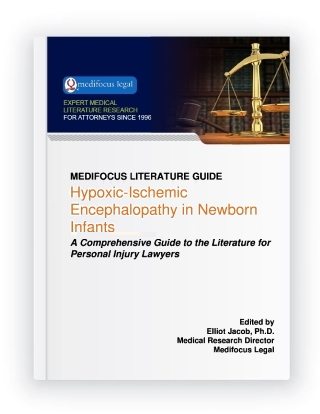Hypoxic-Ischemic Encephalopathy in Newborn InfantsA Comprehensive Guide to the Literature for Personal Injury Lawyers
Publisher: Medifocus Legal
Publication Date: September 1, 2023
Number of Pages: 172
A Comprehensive Guide to the Literature for Personal Injury Lawyers
Publisher: Medifocus LegalPublication Date: September 1, 2023
Number of Pages: 172
The consequences of HIE are typically devastating to both the affected infant and their family. By the age of 2 years, up to 60% of infants with HIE either die or develop severe disabilities including mental retardation, epilepsy, and cerebral palsy. A variety of complications have been implicated as risk factors for developing HIE including placental abruption, placenta previa, uterine rupture, umbilical cord prolapse, breech presentation, shoulder dystocia, and maternal hypotension. In some cases, the exact cause of HIE cannot be identified.
In early postnatal life, the clinical manifestations of HIE include low Apgar scores, the need for respiratory support of the newborn within the first several minutes after birth, abnormal fetal heart rate tracings, presence of meconium stained fluid, and abnormal umbilical cord gases.
The underlying pathophysiologic effects leading to HIE are complex and occur over time. The immediate effect of a hypoxic-ischemic event results in impaired blood flow that limits the amount of oxygen reaching the brain. The decrease in oxygen concentration sets off a cascade of cellular events that results in a massive increase in the intracellular concentrations of calcium and sodium that leads to cerebral edema, microvascular damage, and necrosis of brain tissue. Continued oxygen deprivation over the next 6 to 48 hours leads to the overproduction of free radicals which, in turn, leads to severe oxidative stress resulting in more extensive necrosis and damage to vital brain tissue.
In the past, the treatment options for newborn infants with HIE were limited to supportive medical therapy to maintain cardiopulmonary function and to control seizures. Currently, several novel treatments have become available that include moderate hypothermia, administration of erythropoietin, stem cell transplantation, and antiepileptic medications.
The MediFocus Literature Guide to Hypoxic-Ischemic Encephalopathy in Newborn Infants is a comprehensive Guide to the medical literature for personal injury attorneys who may represent families of infants suffering with HIE. This unique Literature Guide includes over 200 hand-selected references to articles published in peer-reviewed journals with links to the abstracts of the articles. It also includes free online access to the full-text version of 88 articles. The articles included in the Guide represent the current scientific knowledge regarding HIE and focus on a broad range of topics including risk factors, diagnosis, treatment, and outcomes. The Guide also includes a valuable Author Directory for quickly identifying and locating medical experts with specialized knowledge about HIE.
 |
- A comprehensive bibliography of 325 journal article references indexed in MEDLINE published in well respected medical and scientific journals.
- Online access to the abstracts (summaries) of the articles.
- Online access to the free full-text version of 88 articles.
- Links to full-text sources of other articles that are available for purchase directly from individual journal publishers.
- A unique "Author Directory" consisting of the names and institutional affiliations of experts who have published and have specialized knowledge about Hypoxic-Ischemic Encephalopathy in Newborn Infants. The "Author Directory" is a valuable resource for quickly identifying and locating experts for case reviews, opinions, and testimony.
Select examples of topics that are covered by the articles referenced in this Guidebook include:
- Antenatal and Intrapartum Risk Factors for Hypoxic-Ischemic Encephalopathy in a US Birth Cohort.
- Outcomes of preterm infants treated with hypothermia for hypoxic-ischemic encephalopathy
- Long-term neurodevelopmental outcome with hypoxic-ischemic encephalopathy
- The Six-Hour Window: How the Community Hospital Nursery Can Optimize Outcomes of the Infant with Suspected Hypoxic-Ischemic Encephalopathy.
- Ante- and intrapartum risk factors for neonatal hypoxic ischemic encephalopathy.
- Benefits of starting hypothermia treatment within 6 h vs. 6-12 h in newborns with moderate neonatal hypoxic-ischemic encephalopathy.
- Biochemical and clinical predictors of hypoxic-ischemic encephalopathy after perinatal asphyxia
- Hypoxic-ischemic brain injury: Planned delivery before intrapartum events
- Effect of Therapeutic Hypothermia Initiated After 6 Hours of Age on Death or Disability Among Newborns With Hypoxic-Ischemic Encephalopathy
- Predicting motor outcome and death in term hypoxic-ischemic encephalopathy
- Pattern of brain injury and depressed heart rate variability in newborns with hypoxic ischemic encephalopathy.
- Prediction of Future Epilepsy in Neonates With Hypoxic-Ischemic Encephalopathy Who Received Selective Head Cooling.
- Early diagnosis and outcome prediction of neonatal hypoxic-ischemic encephalopathy with color Doppler ultrasound.
- Hypothermia-treated neonates with hypoxic-ischemic encephalopathy: Optimal timing of quantitative ADC measurement to predict disease severity.
- Acute Perinatal Sentinel Events, Neonatal Brain Injury Pattern, and Outcome of Infants Undergoing a Trial of Hypothermia for Neonatal Hypoxic-Ischemic Encephalopathy.
- Neurodevelopmental outcome of term infants with perinatal asphyxia with hypoxic ischemic encephalopathy stage II.
- Outcomes in childhood following therapeutic hypothermia for neonatal hypoxic-ischemic encephalopathy
- Birth Asphyxia and Hypoxic-Ischemic Brain Injury in the Preterm Infant.
- Hypoxic ischemic encephalopathy in newborns linked to placental and umbilical cord abnormalities.
- Long-term motor and behavioral outcome after perinatal hypoxic-ischemic encephalopathy.
is available in two formats: | |
Order by Phone:To order by phone, please call: Order by Mail:To order by mail, please print and complete this Order Form | |

